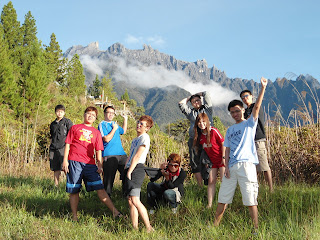Sightseeing in Kota Kinabalu
Kota Kinabalu (Capital City)
 Kota Kinabalu
was formerly known as Jesselton, named after Sir Charles Jessel, one of
the Directors of the British North Borneo Chartered Company, or BNBCC.
During WWII, Kota Kinabalu
and other towns throughout Sabah suffered heavy allied bombing which
all but leveled them. Emerging from the War, the BNBCC discovered it was
too costly to rebuild, so in 1946, Sabah became a British Crown Colony -
until 1963, when Sabah was granted Independence within the Federation
of Malaysia.
Kota Kinabalu
was formerly known as Jesselton, named after Sir Charles Jessel, one of
the Directors of the British North Borneo Chartered Company, or BNBCC.
During WWII, Kota Kinabalu
and other towns throughout Sabah suffered heavy allied bombing which
all but leveled them. Emerging from the War, the BNBCC discovered it was
too costly to rebuild, so in 1946, Sabah became a British Crown Colony -
until 1963, when Sabah was granted Independence within the Federation
of Malaysia.
Kota Kinabalu (Capital City)
On 30th September 1967, Jesselton was renamed Kota Kinabalu.
23 years later, on 2 February, 2000 she was proclaimed a city. As the
capital of the State of Sabah, KK is also the gateway to other major
towns and districts and has a population of around 300,000 .
In the vicinity of the city, there are various places of interest.
Many can be explored on foot while others may be reached by bus or taxi.
The
marine park is a cluster of islands comprising Pulau Gaya, Pulau Sapi,
Pulau Manukan, Pulau Mamutik and Pulau Sulug, all only 10 - 20 minute
speedboat ride from the city of Kota Kinabalu.
The five islands of the Marine Park are characterized by shallow
waters, sumptuous coral gardens and all boast splendid white sandy
beaches.
The reefs lie in shallow waters with little current making it an
ideal location for novice divers, however, the diverse and sometimes
rare marine creatures also make it an interesting dive location for
experienced divers and underwater photographers.
To dive in the marine park you must contact one of the local dive centers based in Kota Kinabalu who also offer a full variety of PADI courses ranging from Discover Scuba to Instructor.
Kota Kinabalu (Capital City)
The Lok Kawi Wildlife Park was officially open to the public on the 17th February 2007. It is located along the Penampang-Papar old road and is fully developed by the Sabah Wildlife Department. The park consists of two components: zoological and botanical. The main objective of the park is to become a family-oriented park and the emphasis is put on the Children’s Zoo. Among the inhabitants of the zoo (zoological component) are the Borneo Pygmy elephants, Sumatran rhinoceros, Orang Utan, Proboscis monkey, Malayan tiger, as well as some different species of deer.The botanical component, on the other hand; offers visitors the opportunity to go jungle trekking along the botanical trail. The paved trail is about 1.4 kilometers long. However, for leisurely strolls, visitors are only advised to walk halfway along the trail.
Kota Kinabalu (Capital City)
Located at the end of Jalan Tunku Abdul Rahman and about 6 kilometres from KK City, this place is closest to the hearts of the locals, and just one visit to the beach will tell you why. Taking its name from the casuarinas or aru trees that fringe the fine sands, this is where one might get a ringside seat to the greatest sunset on earth every evening when the crimson sun dips slowly into the horizon, leaving the vast skies a brilliant red.. Foodstalls serving local food and drinks are open till late at night. Enjoy coconut and sugarcane juice, chicken or beef satay and steamed peanuts and corn, or indulge in a full-course dinner at the seafood restaurant located there.The Tanjung Aru beach is also home to Shangri-la's Tanjung Aru Resort, the Kinabalu Golf Club and the Kinabalu Yacht Club. Getting There:From KK City Centre, take the No 16 bus towards Tanjung Aru from the bus stations in front of City Hall or Wawasan Plaza and let the driver know of your destination. Bus fare is RM1.50. You can also go by taxi, at RM15 per taxi (up to four persons).
Kota Kinabalu (Capital City)
Built in 1985, the Museum complex is sited where then British North Borneo Governor's Istana was once located. The Museum consists of the Main Building, Science and Education Centre, Heritage Village, Sabah Art Gallery and Museum of Islamic Civilization.
Inside are various Galleries housing Natural History, Ceramics, Ethnography and Archaeology exhibits, among others ... Ceramics, traditional weapons and costumes reflect the diversity of
the State's culture and traces Sabah's early trade links with the
neighbouring countries of Southeast Asia and China. The museum also
houses musical instruments, tools and ritual paraphernalia. There is a Heritage Village on the Museum grounds where you can enter
and experience different types of traditional houses of the various
indigenous groups of Sabah. Cultural activities are held here from time
to time. The Sabah State Museum is located on Jalan Bukit Istana Lama, Kota Kinabalu, 4 km or about 15 minutes from the KK City Centre.
Getting There
By bus, take the No.13 (towards Penampang) from either bus stations in front of City Hall or Wawasan Plaza in KK and indicate your stop to the driver. You will have to walk up to the main building. Bus fare is RM1.00.
By taxi, the fare is approximately RM12 to 15.00 for up to 4 persons.
By bus, take the No.13 (towards Penampang) from either bus stations in front of City Hall or Wawasan Plaza in KK and indicate your stop to the driver. You will have to walk up to the main building. Bus fare is RM1.00.
By taxi, the fare is approximately RM12 to 15.00 for up to 4 persons.
Opening hours
Daily from 9.00am till 5.00pm
Daily from 9.00am till 5.00pm
Admission fees
My-Kad - RM2.00
Others - RM15.00
My-Kad - RM2.00
Others - RM15.00





































